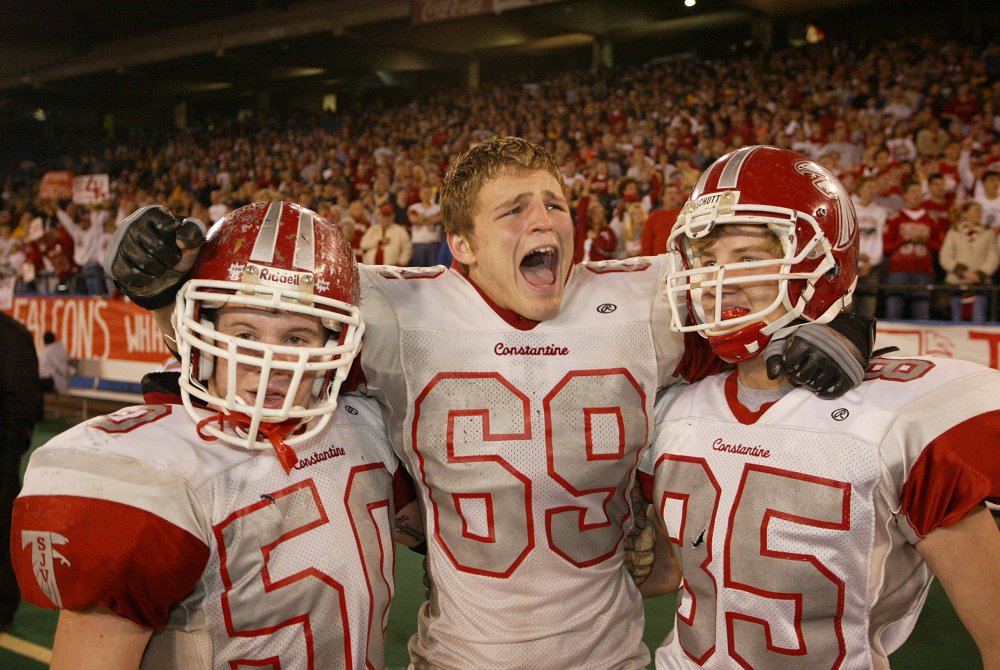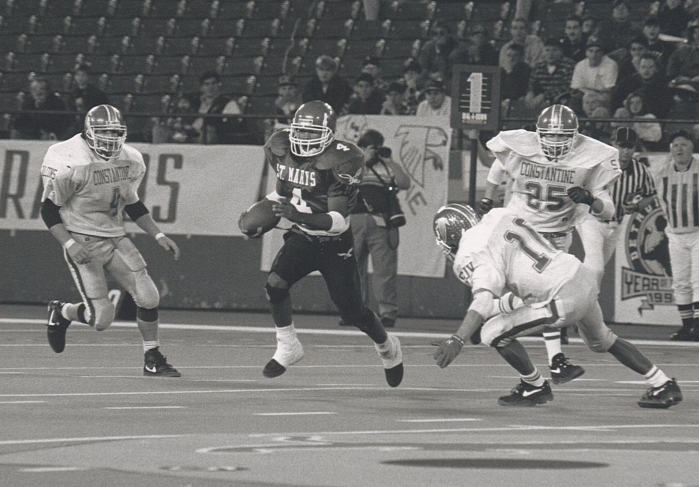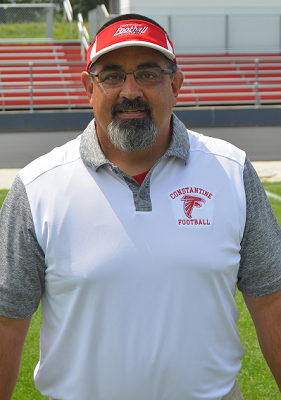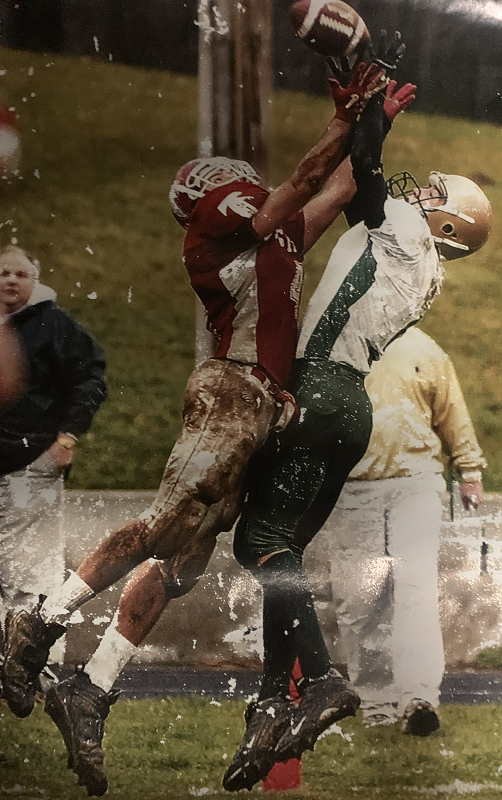
Inside Selection Sunday: Mapnalysis '17
October 22, 2017
By Geoff Kimmerly
Special for Second Half
We haven’t had Michigan high school football teams travel by boat to their playoff games, nor fly like the birds over places like Saginaw Bay and the northern stretch of Lake Michigan.
 But phrases like “use the lake” and “follow the highway” dominated this year’s playoff mapping process, which once again saw members of the MHSAA staff and representatives of the Michigan High School Football Coaches Association draw into Districts and Regionals nearly 300 dots for our 10-division tournament that kicks off this weekend.
But phrases like “use the lake” and “follow the highway” dominated this year’s playoff mapping process, which once again saw members of the MHSAA staff and representatives of the Michigan High School Football Coaches Association draw into Districts and Regionals nearly 300 dots for our 10-division tournament that kicks off this weekend.
At the end of Saturday – around 9:48 p.m., to be nearly exact – there were 223 automatic qualifiers for the 256-team 11-player tournament, plus 32 for 8-player. By midnight, we had our entire playoff field more or less figured. Sunday at the MHSAA started before sunrise with double, triple and quadruple-checking, before a committee of 12 met to draw the tournament, go over all of each other’s work again, and then get everything ready to be presented online at MHSAA.com and broadcast across the state Sunday night on FOX Sports Detroit.
So much more than that goes into the football playoffs, of course. Athletic directors are scheduling games years in advance, and we start loading schedules into our system in late April. We monitor every game played every week by 614 Michigan varsity teams, plus this season 48 of our schools’ non-Michigan opponents located in five states and Ontario. Now we’re on to lining up everything that will come with the next five weeks of games including assigning officials, gathering potential Semifinal hosts and continuing our work with Northern Michigan University and Ford Field’s staffs to prepare for the 8 and 11-player Finals.
But we’re also the first to say that all of that is background noise to what we all look forward to most – five weeks of the best games our state has to offer again this fall.
As we’ve done the past six seasons, we’re explaining below our most difficult decisions in placing 288 playoff qualifiers in this Mapnalysis 2017 breakdown. For those familiar with our playoff selection process, or who have read this report in the past and don’t want a refresher on how we do what we do, skip the next section and go directly to the “Observations & Answers: 2017.” For the rest, what follows is an explanation of how we selected the playoff pairings during the morning hours Sunday, followed by how we made some of the toughest decisions plus a few thoughts on the breakdown of the field. Go to this page on MHSAA.com to see the pairings in full.
Ground Rules
Our past: The MHSAA 11-player playoff structure – with 256 teams in eight divisions, and six wins equaling an automatic berth (or five wins for teams playing eight or fewer games) – debuted in 1999. An 8-player tournament was added in 2011, resulting in nine champions total each season. This fall, a second division of 8-player football was introduced, and we will celebrate 10 champions for the first time.
The first playoffs were conducted in 1975 with four champions. Four more football classes were added in 1990 for a total of eight champions each fall. Through 1998, only 128 teams made the postseason, based on their playoff point averages within regions (four for each class) that were drawn before the beginning of the season. The drawing of Districts and Regionals after the end of the regular season did not begin until the most recent 11-player playoff expansion.
In early years of the current process, lines were drawn by hand. Dots representing qualifying schools were pasted on maps, one map for each division, and those maps were then covered by plastic sheets. Districts and Regionals literally were drawn with dry-erase markers.
Our present: After a late Saturday night tracking scores, we file in Sunday morning for a final round of gathering results we may still need (which can include making a few early a.m. calls to athletic directors and coaches). Re-checking and triple-checking of enrollments, what schools played in co-ops and opted to play as a higher class start a week in advance, and more numbers are crunched Sunday morning as the fields are set.
As noted above, this season there were 223 automatic qualifiers for the 11-player field by win total with the final 33 at-large qualifiers then selected, by playoff-point average, one from each class in order (A, B, C, D) until the field was filled. There were only five Class D additional qualifiers with 5-4 or 4-4 (playing eight games) records from which we could choose – so after those five we added 10 teams from Class A and nine each from Class B and Class C.
Those 256 11-player teams are then split into eight equal divisions based on enrollment, and their locations are marked on digital maps that are projected on wall-size screens and then discussed by nearly half of the MHSAA staff plus this year two representatives from the Michigan High School Football Coaches Association. Only the locations themselves are marked (by red dots) – not records, playoff point averages or names of the schools or towns. In fact, mentions of those are strictly prohibited. Records and playoff points are not part of the criteria. Matchups, rivalries, previous playoff pairings, etc. also DO NOT come into play.
The 8-player process is similar but changed this fall with the additional division. We take the top 32 teams in 8-player based on playoff point average as our field, then re-sort those 32 by enrollment – the 16 biggest make up Division 1, followed by the next 16 in Division 2. There are no automatic qualifiers by record for 8-player.
Geography rules: This long has been rule number one for drawing MHSAA brackets in any sport. Travel distance and ease DO come into play. Jumping on a major highway clearly is easier than driving across county-wide back roads, and that’s taken into consideration. Also, remember there’s only one Mackinac Bridge and hence only one way to cross between peninsulas – and boats are not considered a possible form of transportation. When opponents from both peninsulas will be in the same District, distance to the bridge is far more important than as the bird flies.
Tradition doesn’t reign: Every group of 32 dots is a new group – these 32 teams have not been placed in a bracket together before. How maps have been drawn in the past isn’t considered – it’s hard to say a division has been drawn in a certain way traditionally when this set of 32 teams is making up a division for the first time.
Observations & Answers: 2017
Let’s start with Congratulations: First to Detroit Western and St. Louis, which qualified for the MHSAA Playoffs for the first time. Then to seven more headed back for the first time in a while: Athens (first berth since 2000), Bridgeport (1999), Flat Rock (1990), Hancock (2006), Royal Oak (2006), Salem (1991) and Vermontville Maple Valley (2005). A total of 21 programs added to totals of more than 25 playoff berths, led by Beal City now with 35, Crystal Falls Forest Park and Farmington Hills Harrison with 33, Mendon with 32, Traverse City St. Francis with 31 and Frankfort with 30. Rockford earned its 23rd straight playoff berth, tying the record set by Felch North Dickinson from 1991-2013, and Menominee earned its 22nd straight to tie Traverse City St. Francis (1990-2011) for third on the list. Of our current 614 football varsities, all but 16 have made the playoffs at least once.
Break the tie: We again had to break a tie as teams that will or could meet ended up with the same playoff point averages. Ties are broken by head-to-head competition first – if the teams played each other during the regular season – followed by opponents’ winning percentage as the second criteria and then a coin flip if those two won’t do it. Cedarville will host Rudyard in an 8-player Division 1 game this week although both teams finished with the same playoff point average – Cedarville broke the tie with its 46-28 win over the Bulldogs in Week 1, which is a good thing because their opponents had matching 38-43 records this fall.
Many ways, no great way to slice it: The map in 11-player Division 2 was among our first tough challenges Sunday. Our most northern District seemed to make sense right away – keeping Traverse City West and Traverse City Central together with Midland and Midland Dow. From there, it’s not a pretty picture. We looked at three ways of splitting up the Detroit-area schools. We have five teams on the Grand Rapids/Muskegon/Kalamazoo side of the Lower Peninsula, but Lowell being eastern-most got sent to a District with three Flint-area schools. The 11-player Division 3 map provided a similar quandary – DeWitt, East Lansing and Haslett are packed nicely just north of Lansing, but an uneven seven schools on the western side of the Lower Peninsula meant DeWitt getting grouped with three closer to Grand Rapids with East Lansing and Haslett heading south to join Parma Western and Tecumseh. Bay City Central is the lone qualifier in this division from the Bay City/Saginaw/Midland area and also had to go somewhere – and in this case it made more sense to send it south along I-75 then across to Grand Rapids.
It’s a highway thing: In both Division 4 and Division 6 of 11-player, we have one Upper Peninsula school joining the rest from downstate. In Calumet’s case in Division 6, there are opponents in the northern Lower Peninsula to slot against, but Escanaba in Division 4 left us again relying on I-75. The trip from Escanaba to Flint Powers Catholic – the southernmost team in that four-team District – seems like a longer haul than sending Escanaba instead southwest to Whitehall. But a trip to Powers is estimated to be an hour shorter than from Escanaba to Whitehall, again because of the main highway.
Use the lake: At least three of our 11-player divisions – 1, 2 and 5 – have a District that rides close to the southeastern region of the Lower Peninsula up from Macomb County into Port Huron. While those thin Districts seem a little odd in shape, they make sense by normal traffic flow up from Lake St. Clair toward the Lake Huron coast. That helps explain why Port Huron Northern is with Roseville, Warren DeLaSalle and Ferndale instead of taking Lowell’s spot with Fenton, Flushing and Flint Carman-Ainsworth.
Worst map ever: At least in my seven years of being a part of the process. I’m speaking of the 11-player map in Division 8, which saw us with six Upper Peninsula schools, but then three Lower Peninsula schools grouped together just below Mackinac Bridge. One of these three had to go with another group, which is how we ended up with Frankfort joining Munising, Newberry and Gaylord St. Mary (Johannesburg-Lewiston and Hillman ended up with AuGres-Sims and Lincoln Alcona.). Then there are the pair of triangles in the southwest Lower Peninsula with Muskegon Catholic Central and Fulton-Middleton a good deal north of their District opponents, but with no other way to group those teams since the other six are all along I-94 or just south. It’s not pretty, but splitting MCC and Fulton up and sending them south was the best of the options we developed.
At the end of the day …
So here’s the fun part. We draw the maps without knowing who is where – and then we take a look at the matchups as they’re being prepared for TV and online.
It’s hard to pick out only a handful to mention at this time, but here’s one guess at a few that will create a buzz this week:
• In Division 1, Holland West Ottawa hosts Grandville after beating the Bulldogs 34-18 in Week 9 to earn an outright Ottawa-Kent Conference Red title; a Grandville win would’ve given championship shares to both and Rockford.
• Also in Division 1, Bloomfield Hills travels to West Bloomfield after beating the Lakers 28-24 in Week 2; West Bloomfield hasn’t lost again.
• In Division 3, Zeeland West and Zeeland East face off again after East downed West 28-8 on Friday to win the O-K Green championship.
• Also in Division 3, DeWitt hosts Grand Rapids Christian after rattling off eight straight wins – the Panthers’ only loss was to Christian 38-30 on opening night.
• Rivals Wyoming Kelloggsville and Godwin Heights meet in Division 4 after Kelloggsville beat Godwin by a point in Week 6 on the way to winning the O-K Silver title. Three Rivers and Vicksburg also will meet for the second straight week, this time in a Division 4 game; Vicksburg beat Three Rivers on Friday to deny the Wildcats a share of the Wolverine B Conference title. Harbor Beach claimed the Greater Thumb Conference East title by downing Ubly 26-14 in the league finale in Week 8, and they’ll meet again this week in Division 8.
• The best rivalry in 8-player last year was Powers North Central versus Crystal Falls Forest Park, and they’ll meet to start this postseason with the reigning champion Jets hitting the road looking to avenge a 66-58 loss to the Trojans in Week 2.
We know every game over the next five weeks will be memorable, at least for those on the field and the communities cheering them on. With our maps drawn, we look forward watching championship roads get blazed – and we’ll be waiting where they end at NMU and Ford Field.
The MHSAA Football Playoffs are sponsored by the Michigan National Guard.
PHOTOS: (Top) The Division 4 bracket mapped out on the Lower Peninsula shows how I-75 served as a guide for putting Escanaba in a District that includes Flint Powers Catholic.

Constantine Celebrates 100th Season, Renowned for Continuity & Signature Wing-T
By
Scott Hassinger
Special for MHSAA.com
September 6, 2023
CONSTANTINE – Bennett Vandenberg and Cohen McGee are just like any other high school football players.
 Both Constantine seniors have high aspirations of winning a fifth-straight Southwestern Athletic Conference Lakeshore title and reaching the postseason.
Both Constantine seniors have high aspirations of winning a fifth-straight Southwestern Athletic Conference Lakeshore title and reaching the postseason.
But Vandenberg and McGee, along with their Falcons teammates, will be celebrating more than victories and a potential playoff appearance this fall.
Constantine, a community located in southern St. Joseph County, is observing the 100th season of the school's football program.
The Falcons (1-1) will commemorate the occasion Saturday, Oct. 7, with a home game against SAC Lakeshore foe Kalamazoo United. Kickoff time from Sweetland Stadium is 1 p.m. The game will be followed by a community luncheon and program in the high school at which time past coaches, players and the program's biggest accomplishments will be recognized and celebrated.
Vandenberg, a starting fullback/tight end and outside linebacker, and McGee, an offensive lineman and linebacker, are both looking forward to the rest of the season and continuing Constantine's strong tradition on the gridiron.
"We have a huge football tradition here at Constantine. This year we're celebrating the 100th year, and we have some of the oldest living players coming back to help celebrate after that game with United,” said Vandenberg, a three-year starter and Finals placer his junior year in wrestling and track & field. “Our community is all about football. We know we have to go out there and represent our school and community the right way."
McGee is following in the footsteps of his older brother Carter.
"There are lots of things that people who follow Constantine football don't see, like the hours of dedication and work we put in during the offseason. That's where we make our strides and become better as a program," McGee said.
The football stadium at Constantine is named after Dr. George Sweetland, a physician in the community, who donated money for a football stadium to be built with a hill completely circling the facility.
 Sweetland, who moved to Constantine in 1916 to take over his brother's medical practice after the latter was killed in a car crash, reportedly allowed patients to work off their medical bills by helping with the stadium's construction.
Sweetland, who moved to Constantine in 1916 to take over his brother's medical practice after the latter was killed in a car crash, reportedly allowed patients to work off their medical bills by helping with the stadium's construction.
Constantine, which played its first football game in 1924 and finished as county champs at 4-2 under coach Lew Lake, sports an all-time record of 481 wins and 221 losses with 11 ties. During that span, the Falcons have enjoyed 11 unbeaten seasons, including Robert Finlay's 1937 squad that went 8-0 and was unscored upon.
Coaching longevity is one of the biggest factors allowing Constantine to be as successful as it has been, especially during the program's modern era. The Falcons have had just four head coaches since 1964.
Mike Messner, a three-sport athlete and 1965 Constantine graduate, later served as the school's athletic director from 1992-2016.
Messner pointed to Meredith 'Spud' Huston, Constantine's football coach from 1958-1961, as one of the first individuals influential in setting the wheels in motion for the program's future success.
Huston guided the Falcons to their first league title in 1961.
Constantine's four winningest coaches – Dave Horn, Tim Baker, Ken Rimer and Shawn Griffith – are all honorary members of the Michigan High School Football Coaches Association's Hall of Fame.
Horn, who died earlier this summer, served two stints as Constantine's head coach from 1964-1981 and 1987-1989 while compiling a 116-65-4 record.
Baker (129-30) coached Constantine for 15 seasons and guided the Falcons to a record of 129-30. Under Baker, the Falcons were Division 6 champs in 2004 and Finals runners-up in 1994 (Class CC) and 2002 (Division 5).
"Dave (Horn) was a genuinely great person who coached 21 years. He could get upset at you on the field, but he was a very kind, storyteller and a thoughtful guy who really cared about others," Messner said.
 "In the modern coaching era, Tim (Baker) really believed in lifting weights, making kids stronger and developing kids into good football players. He was diligent, hardworking and put a lot of time into the program while missing a lot of family functions. He concentrated on doing the best job he could. Ken (Rimer) was right there in the same mode as Tim. When they started coaching together, they wanted a program that kids at Constantine could be proud of. Things started really happening, and ever since then the program has been strong. We have coaches who want Constantine to be successful on the field."
"In the modern coaching era, Tim (Baker) really believed in lifting weights, making kids stronger and developing kids into good football players. He was diligent, hardworking and put a lot of time into the program while missing a lot of family functions. He concentrated on doing the best job he could. Ken (Rimer) was right there in the same mode as Tim. When they started coaching together, they wanted a program that kids at Constantine could be proud of. Things started really happening, and ever since then the program has been strong. We have coaches who want Constantine to be successful on the field."
Rimer spent 28 years as an assistant coach under Baker and current head coach Shawn Griffith. Constantine compiled a win-loss mark of 242-70 with Rimer as an assistant.
Griffith, who took over as Constantine's head coach in 2005, is the Falcons’ all-time winningest coach at 156-53. Under Griffith's tutelage, the Falcons have made 17 playoff appearances, with back-to-back Division 6 runners-up finishes in 2011 and 2012.
"The history of Constantine football kind've coincides with everything else here in the community. This is my 32nd year overall as a coach in this program. But I also have several memories from when I was in high school at Mendon as a player going up against Constantine," Griffith said.
"When you talk about any community our size, you immediately look at family names. We have another Stears (Lucas) on this year's team. Mike (Messner) told me there have been over 20 from the Stears family that have worn the Falcon uniform. It doesn't stop there. I look at the number of kids we have in the locker room this year, and I realize that I've coached many of their brothers, fathers and uncles. We look at the program as one big family. This program has helped to raise a lot of young men in the area these last few years. The community has been extremely supportive of the program as well."
Constantine won 19 league championships as a member of the St. Joseph Valley League from 1952-2007. That league consisted of Constantine, White Pigeon, Schoolcraft, Centreville, Colon, Climax-Scotts, Burr Oak and Mendon. Bronson and Battle Creek St. Philip became members later after Climax-Scotts and Burr Oak left to join the Southern Central Athletic Association. Eventually, the SJV disbanded due to conference realignment and declining enrollment among its smaller schools.
 At one time, Constantine played in one of the longest-running rivalries in state football history. The Falcons and archrival White Pigeon began playing one another in 1924 and Constantine held a 47-35-6 in the rivalry, with wins in the final 17 meetings before the series ended after the 2007 season.
At one time, Constantine played in one of the longest-running rivalries in state football history. The Falcons and archrival White Pigeon began playing one another in 1924 and Constantine held a 47-35-6 in the rivalry, with wins in the final 17 meetings before the series ended after the 2007 season.
Messner recalls the 1981 meeting between White Pigeon and Constantine as one of the most memorable. The game was played at the Sweetland Stadium in Constantine, and there were more than 5,000 people in attendance.
"White Pigeon came into that game unscored upon and ranked No. 1 in the state. We were undefeated, but nobody was saying anything about us, but they were really talking (White Pigeon) up," Messner said. "(White Pigeon) had brought over 1,000 balloons with them and hid them behind the bleachers. They were going to launch them every time they scored. They never scored, and we beat them 21-0. It was such a sad moment for both schools when they had to stop playing one another in football."
After the SJV dissolved, Constantine and Schoolcraft became members of the Kalamazoo Valley Athletic Association from 2008-2014 before leaving to join the Southwestern Athletic Conference for the 2015 season. Constantine begins its ninth season competing in the SAC Lakeshore against the likes of Watervliet, Allegan, Kalamazoo United, South Haven and Parchment.
Messner also lists several playoff games as big moments in Constantine's football history.
"Our first playoff team (1991) was a big year, and our first state finals appearance (1994) was another," Messner added.
Constantine lost to Orchard Lake St. Mary's (35-7) in the 1994 Class CC Final, but knocked off heavily-favored Fennville (50-0) in their Pre-Regional and Whittemore-Prescott (54-6) in a Semifinal to get there.
"Both teams were considerably bigger than us up front on the line. Fennville had a really good quarterback (Frank Alfieri) and Whittemore-Prescott had a great tailback (Tom 'Touchdown' Tyson) that our much smaller guys managed to shut down," Messner said. "Then there was a 13-7 win we had in the 2002 Regional Finals over heavily-favored Muskegon Oakridge."
But perhaps the 2004 Semifinal deemed 'The Miracle in Marshall' will go down as the most memorable game in Constantine history. In that contest, Constantine trailed Monroe St. Mary Catholic Central 27-14 with a little more than six and a half minutes to go in the fourth quarter.
The Falcons scored twice during those last few minutes, including a last-second 32-yard TD pass from Aaron Baker to Sean Wolf caught in the end zone that tied the game at 27-27 with one second left. Jordan Williams booted the PAT as time expired, giving the Falcons a 28-27 win.
Constantine went on to defeat Suttons Bay 34-13 in the Division 6 Final the following week.
 From 1991-2015, Constantine attained at least seven wins for 25 consecutive years, which is a state record. The Falcons made 18 consecutive playoff appearances from 1999-2016 before suffering their most recent losing season in 2017, when they finished 3-6.
From 1991-2015, Constantine attained at least seven wins for 25 consecutive years, which is a state record. The Falcons made 18 consecutive playoff appearances from 1999-2016 before suffering their most recent losing season in 2017, when they finished 3-6.
Constantine's overall playoff record stands at 49-25 with 26 total appearances.
It was Griffith, who played his high school football at Mendon for Class D championship-winning coach Roger Smith and his then-assistant John Schwartz (who would later lead the Hornets to 10 more Finals titles) who convinced Baker the Falcons should transition from the I-Formation to the Wing-T offense.
After much discussion and argument among the coaching staff, Baker reluctantly agreed to Griffith's idea.
"I joined the coaching staff in 1992 as offensive coordinator. As a coaching staff, we really came into our own and made our first run to the Finals in 1994. In the late ’90s we had some really good teams, but still didn't quite have a real identity. During that time we ran into some really good Wing-T football teams," Griffith said.
"We started noticing that we had a real hard time stopping these teams that ran the Wing-T like Muskegon Orchard View, Hopkins and Battle Creek Pennfield. So I came to Tim (Baker) after the 2001 season with the idea of changing the offense. We knew we had a tremendous group of running backs coming up through the program for the next seven or eight years. I approached him about running the Wing-T. He wasn't real receptive at first about running it. But after sitting down with other Wing-T coaches like John Shilito (Muskegon Orchard View) and Irv Sigler (Belding), he agreed to give it a try."
Constantine began running the Wing-T at the start of the 2002 season.
"Once you get known for running an offense like this, it kind've becomes your niche. I get emails from people all over the United States wanting me to come teach them this offense at camps. Here at Constantine, we've been fortunate to rack up quite a few wins since we installed this offense. Our kids can really talk the Wing-T game, and we didn't really have that before when we were running our I-formation and single-back stuff," Griffith said.
"The blocking schemes have become ingrained in our kids. They do a great job of knowing where they are supposed to be and who they are supposed to block. Another thing I really like about the Wing-T is it's a lineman's offense. Our linemen get a lot of credit, which they deserve. There is a certain toughness to this offense as well. It's allowed us to use kids who might be smaller and less athletic, but still allows us to be successful because they have developed a certain toughness."
Griffith credits a lot of that toughness to his players who compete on the Falcons' wrestling team during the winter sports season. Constantine’s wrestling program also has enjoyed a long run of success, including a Class C-D title in 1993 and Division 3 runner-up finish in 2002. The Falcons have won Team Regional titles three straight seasons.
 Scott Hassinger is a contributing sportswriter for Leader Publications and previously served as the sports editor for the Three Rivers Commercial-News from 1994-2022. He can be reached at [email protected] with story ideas for Berrien, Cass, St. Joseph and Branch counties.
Scott Hassinger is a contributing sportswriter for Leader Publications and previously served as the sports editor for the Three Rivers Commercial-News from 1994-2022. He can be reached at [email protected] with story ideas for Berrien, Cass, St. Joseph and Branch counties.
PHOTOS (Top) Constantine players celebrate near the end of their 2004 championship win at Pontiac Silverdome. (2) A trio of Constantine defenders pursue Orchard Lake St. Mary’s Phil Martin (4) during the 1994 Class CC Final. (3) Longtime Constantine athletic director Mike Messner. (4) Current Constantine head varsity coach Shawn Griffith. (5) The 2004 “Miracle in Marshall” remains one of the most memorable games in Constantine football history. (Finals photos from MHSAA archive. “Miracle in Marshall” photo by Dick Carter. Messner and Griffith photos gathered by Scott Hassinger.)

